Use of Non-Uniform Sampling (NUS) in 2D NMR
Non-Uniform Sampling (NUS) has found increasing use in small molecule 2D NMR in recent years. The NUS method, when done with moderate (~ 50%) sparse sampling, cuts down data collection time significantly with little to no loss in data quality. This instruction provides the simple steps you may take to set up a 2D experiment with NUS under Bruker Topspin or IconNMR. For further reading about the history and applications of NUS in NMR, refer to the literature references below.Background
Traditional NMR data collection is done with discrete, uniform sampling (US), that is, equal time increment and digitization to the longest time points, in both the direct and indirect dimensions. For example, with a spectral width of 10,000 Hz ( ~ 20 ppm for 1H at 500 MHz) in the direct dimension and an acquisition time of 2 sec, the data is recorded every 1/10,000 sec or every 0.1 msec, for a total of 2/0.0001 or 20,000 complex points.In a 2D phase-sensitive, 1H-13C HSQC experiment, if the indirect 13C dimension is set with 170 ppm width (or ~ 21,250 Hz on Bruker 500) and 256 points (Real + Imaginary, or 128 complex points), then an increment of 1/21,250 sec or 0.047 msec is used for 128 complex points along the 13C dimension; the longest 13C evolution recorded is 128*0.047 msec or ~6 msec. For this 2D experiment, a total of 256 (Real + Imaginary) unique 1H FIDs are recorded, each encoded with an evenly spaced 13C increment. With 8 scans, a recycle delay of 1.5 sec and an acquisition time of 0.2 sec, the 2D takes 8*(1.5+0.2)*256 ~ 3,482 sec or 58 min. Fourier Transform (FT) of these time-domain data relies on the discrete and uniform sampling.
The NUS technique records the data with a non-uniform schedule along the roughly exponential, temporal decay curve. This isn't useful for the direct dimension, but the sparse data collection with optimized spacing along the indirect dimension in 2D NMR has been shown to save time with little to no loss in data quality. In the 2D HSQC above, with NUS and 50% sparse sampling (or 128 points), the data collection time is cut in half to 29 mins.
The primary limitations of NUS are the sample concentration and spin relaxation times. Cautions must be used when aggressively cutting down data sampling amount; artifacts and missing peaks may occur in such extreme cases (see examples below). For the best data quality, if possible, always use more material (higher concentration) with US or NUS at 50%. Keep in mind that the primary goal of NUS is time saving. Its quality at the current stage is approaching that of US (with longer data collection time) but doesn't surpass it.
Steps to Set up NUS
NUS has been integrated into both Bruker's Topspin software and the data processing software Mnova. All 2D data collection under Topspin is set to use uniform sampling by default. To turn the same 2D setup to use NUS, follow the few steps below. Due to the consistent artifacts observed in our test data with very low sampling amount, stay with 50% sparse sampling. If the default amount is lower, set it to 50%.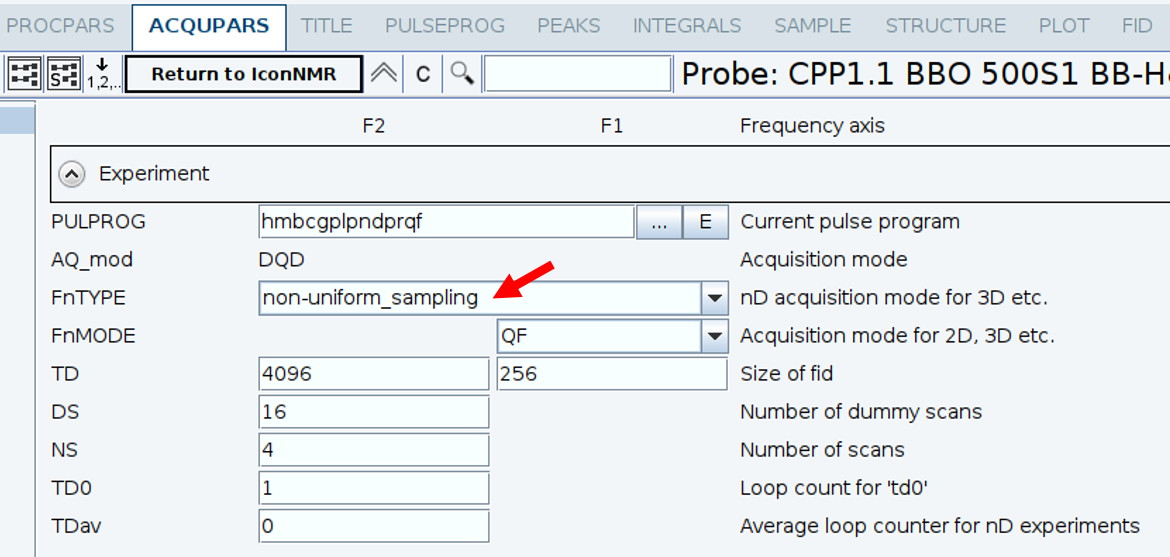 Select NUS | 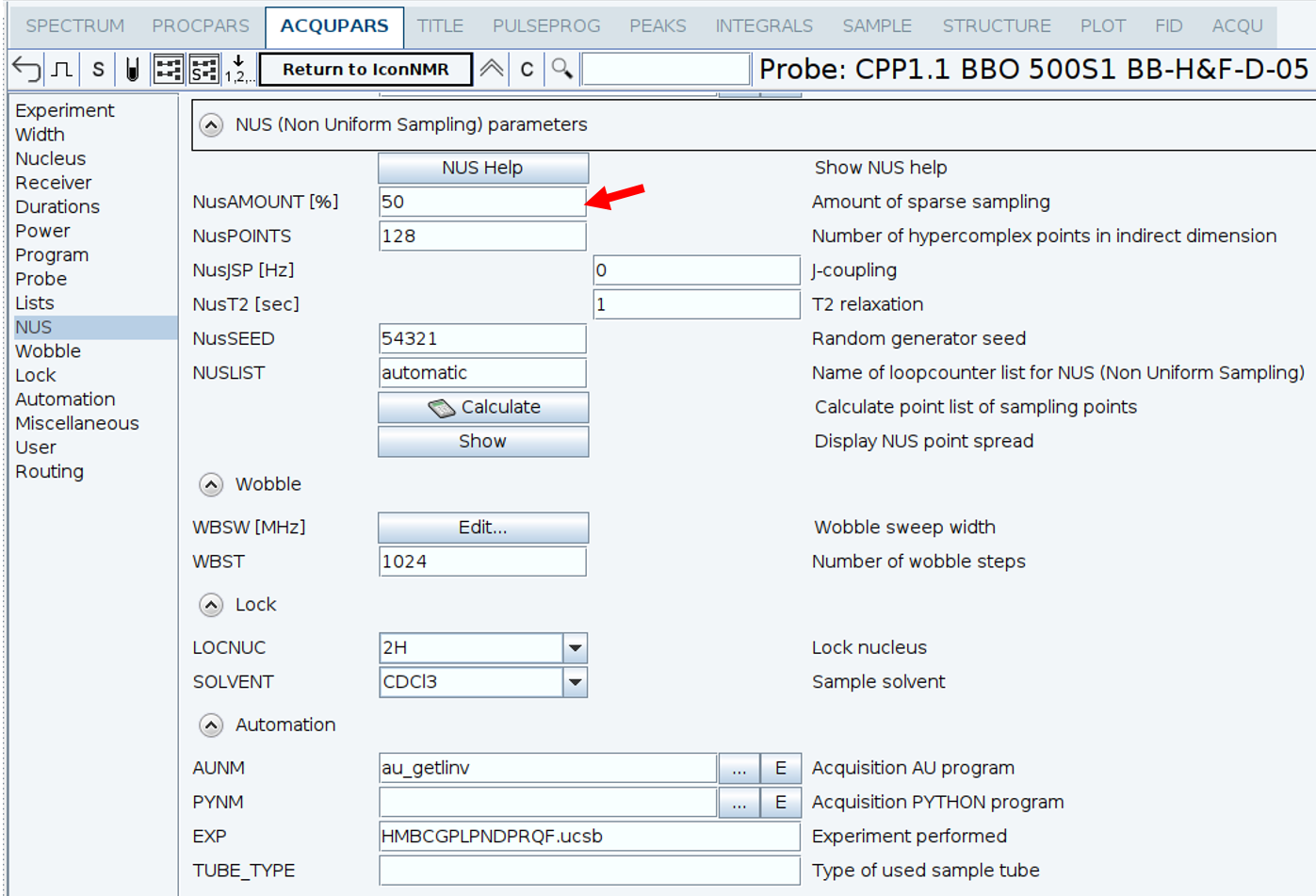
Adjust sparse sampling amount (%) along indirect (F1) dimension. NUSPOINTS changes accordingly. |
- In IconNMR, select/set up the 2D experiment as usual. Then, in the top menu items, click Parameters→Edit All Parameters.
- Go to ACQUPARS panel. Under FnTYPE, select non-uniform sampling.
- In the left panel list, click NUS and adjust the amount of sparse sampling. Leave all other NUS related parameters alone. In most cases, simply keep or change the sampling rate to 50% under NusAMOUNT. This effectively halves the data collection time of the uniform sampling (leading to NusPOINTS of 128 instead of 256 as shown under QF in the left figure in this example).
- Optionally, you may use the time saving for more scans with 50% NUS.
- After the adjustment, click Return to IconNMR and submit the experiment under IconNMR.
- Data Processing: NUS data are automatically recognized in Mnova and Topspin although data processing takes longer.
Example Data
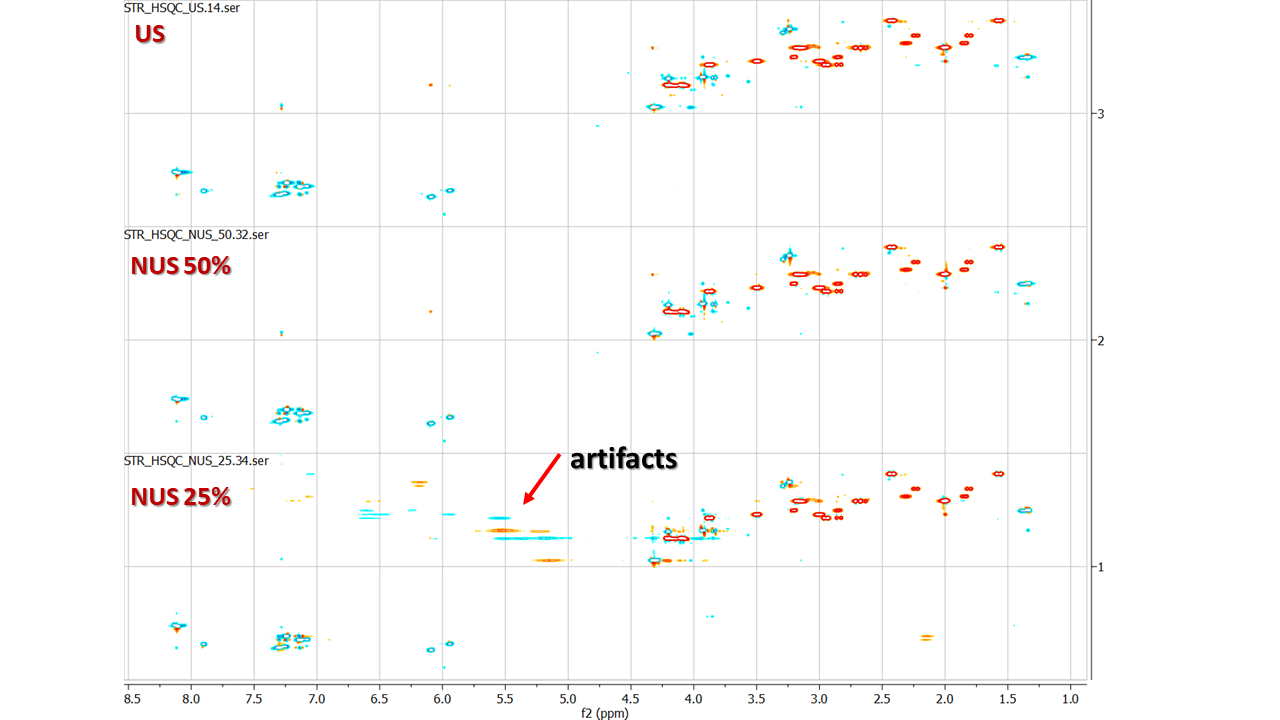 1H-13C HSQC: artifacts with less sampling | 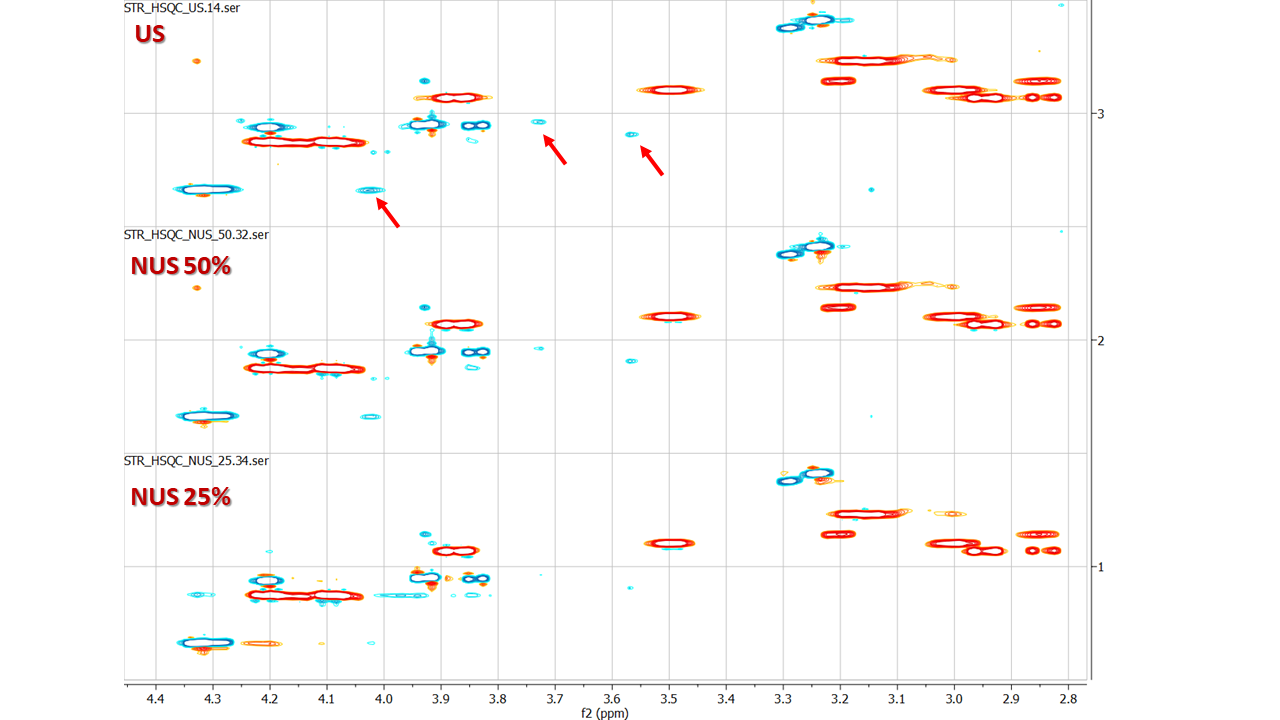 Small peaks are weakened with less sampling. |
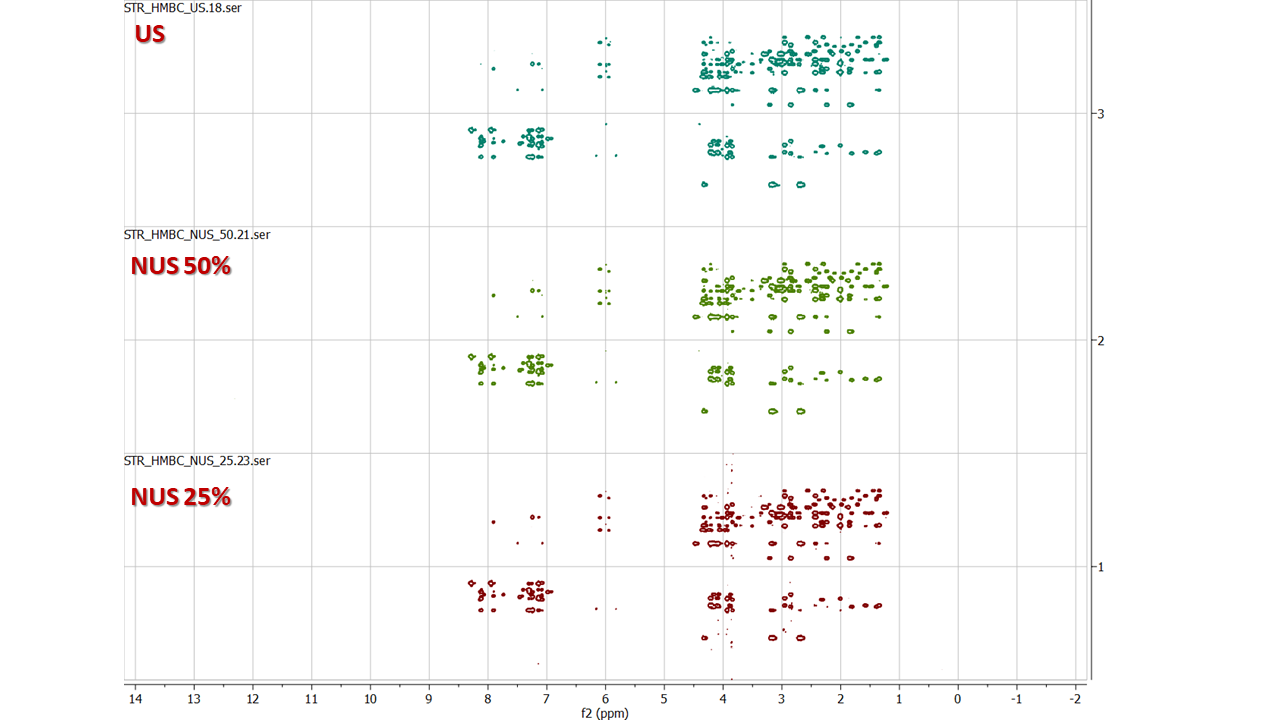 1H-13C HMBC: mostly artifacts free | 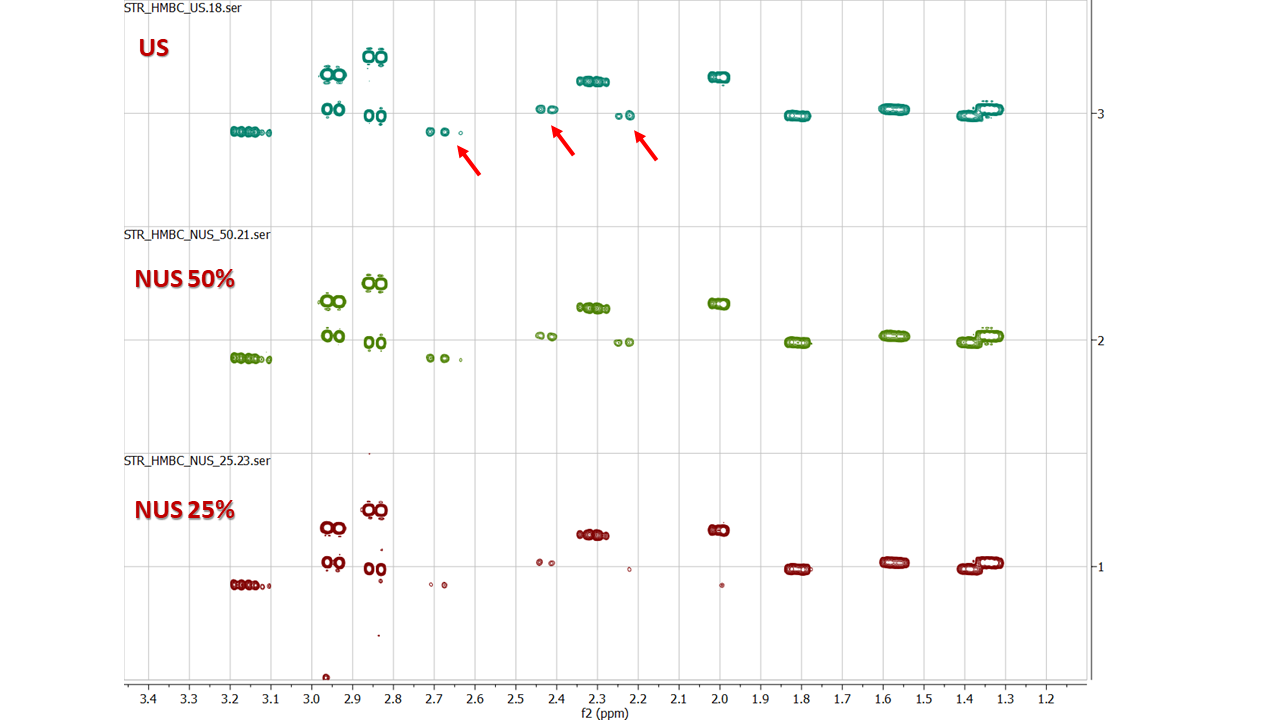 Small peaks are weakened with less sampling. |
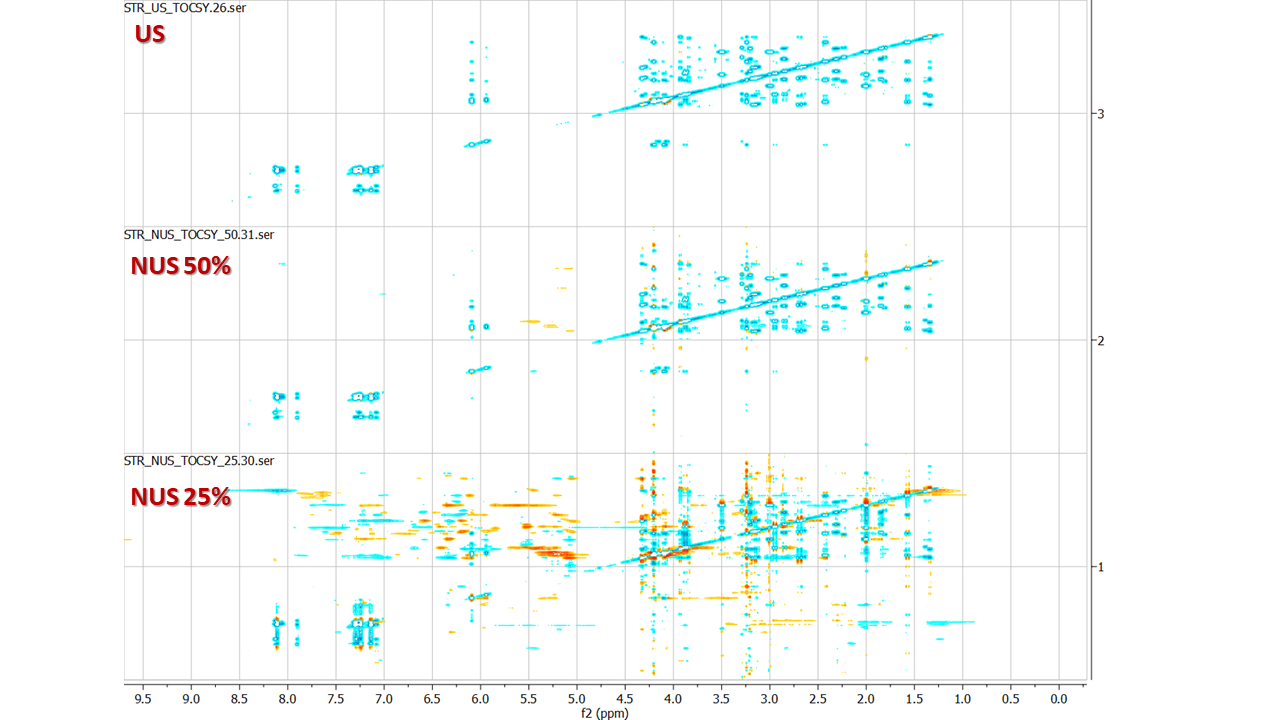 1H-1H TOCSY: significant artifacts observed with 25% sampling | 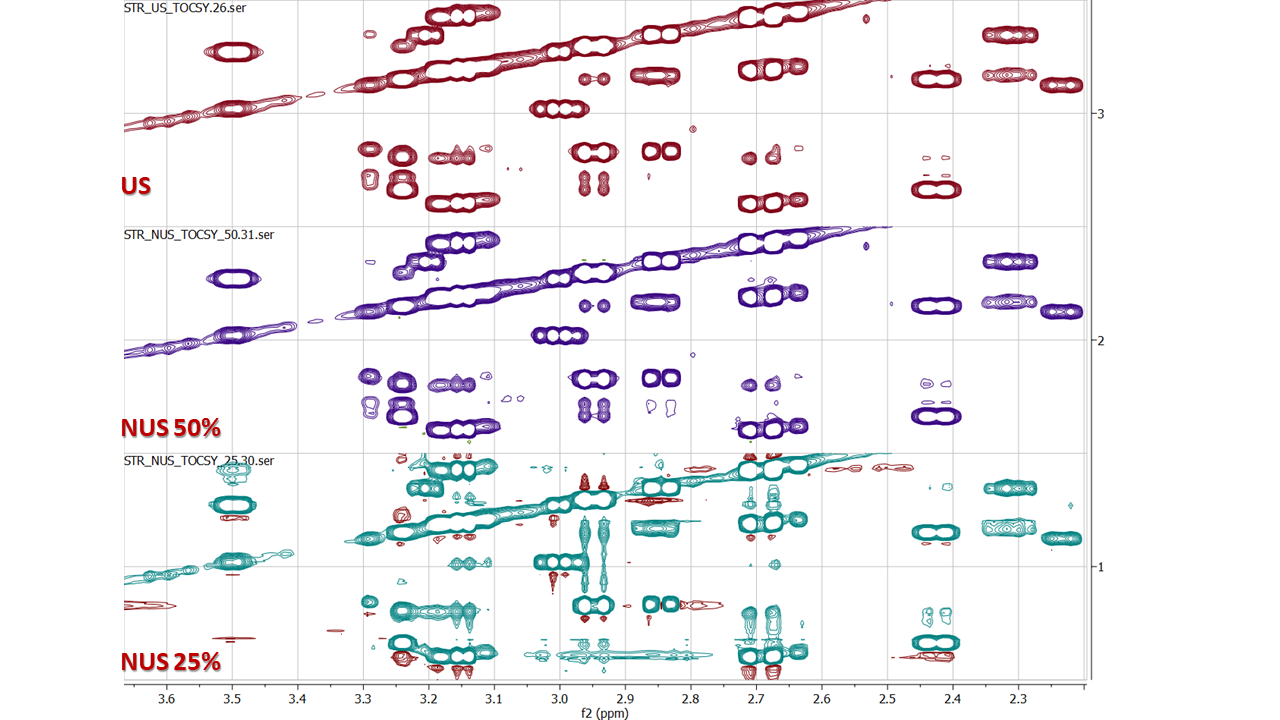 Expanded region of TOCSY |
NUS test: Stacked plot of 2D spectra collected using uniform sampling (US, 100%) or 50% or 25% non-uniform sampling (NUS) along
the indirect dimension (F1). Use 50% and avoid lower amount due to signifcant artifacts observed here with more aggressive, low sampling rate. The sample is 20 mg Strychnine in ~ 700 uL of CDCl3. A set of small peaks
are from ~ 20-30% decomposed products. All data here were collected on Bruker 500 and processed with Mnova.
References
Original Work- Exponential Sampling, an Alternative Method for Sampling in Two-Dimensional NMR Experiments. J. C. J. BARNA, E. D. LAUE, M. R. MAYGER, J. SKILLING, AND S. J. P. WORFZALL, J. Magn. Reson. 73 (1987), 69-77.
- Conventional and Exponential Sampling for 2D NMR Experiments with Application to a 2D NMR Spectrum of a Protein J.C.J. Barna, E.D. Laue, J. Magn. Reson., 75 (1987), 384-389.
- NUS data processing in Mnova
- Non-Uniform Sampling for All: More NMR Spectral Quality, Less Measurement Time. Frank Delaglio, Gregory S. Walker, Kathleen A. Farley, Raman Sharma, Jeffrey C. Hoch, Luke W. Arbogast, Robert G. Brinson, and John P. Marino. Am Pharm Rev. 2017 20(4), 339681.
- Systematic Evaluation of Non-Uniform Sampling Parameters in the Targeted Analysis of Urine Metabolites by 1H,1H 2D NMR Spectroscopy. Schlippenbach, T.v., Oefner, P.J. & Gronwald, W. Sci Rep 8, 4249 (2018). https://doi.org/10.1038/s41598-018-22541-0
- Non-Uniform Sampling in NMR Spectroscopy and the Preservation of Spectral Knowledge in the Time and Frequency Domains. Manpreet Kaur, Callie M. Lewis, Aaron Chronister, Gabriel S. Phun, and Leonard J. Mueller. The Journal of Physical Chemistry A 2020 124 (26), 5474-5486 DOI: 10.1021/acs.jpca.0c02930
- Poisson-Gap Sampling and Forward Maximum Entropy Reconstruction for Enhancing the Resolution and Sensitivity of Protein NMR Data. Sven G. Hyberts, Koh Takeuchi, and Gerhard Wagner, Journal of the American Chemical Society 2010 132 (7), 2145-2147. DOI: 10.1021/ja908004w
Posted on December 7, 2022 By H. Zhou
